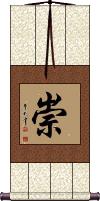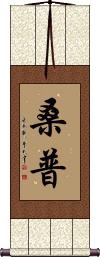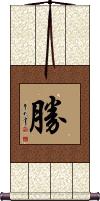Many custom options...
And formats...

Sung in Chinese / Japanese...
Buy a Sung calligraphy wall scroll here!
Personalize your custom “Sung” project by clicking the button next to your favorite “Sung” title below...
Chong / Sung / Su
Surname
This is the surname “Chong” or “Zhong” in Mandarin Chinese, “Sung” in Cantonese and Korean, and Su in Japanese.
崇 is used in other Chinese words and other Asian languages with the following meanings:
high; sublime; lofty; to esteem; to worship; eminent; honorable; honourable; reverence; adore/adoration.
Thumper
桑普 is a common transliteration to Mandarin Chinese for the name Thumper.
This is a difficult name to transliterate since there are no initial “th” or final “r” sounds in Chinese. This version sounds like “Sung pu.”
This is the official Chinese name used for Thumper, the rabbit from the Disney movie Bambi.
Win / Victory
勝 is a single character that means to win or be victorious.
This can also be translated: To overcome; success; to beat; to defeat; to surpass; superior to; to get the better of; better than; surpassing; superb.
In another context, this can mean beautiful (scenery); scenic spot; or scenic beauty.
In Taiwanese Mandarin, this can be pronounced with the first tone (sheng1) and mean: Able to bear; equal to (a task).
In Japan, this can also be the name Masaru.
In Korea, this has the same meaning but can also be the surname Sŭng.
Not the results for Sung that you were looking for?
Below are some entries from our dictionary that may match your Sung search...
| Characters If shown, 2nd row is Simp. Chinese |
Pronunciation Romanization |
Simple Dictionary Definition |
宋 see styles |
sòng song4 sung son そん |
surname Song; the Song dynasty (960–1279); Song of the Southern Dynasties (420–479) 南朝宋[Nan2 chao2 Song4] (1) (hist) Song dynasty (of China; 960-1279); Sung dynasty; (2) (hist) Liu Song dynasty (of China; 420-479); Liu Sung dynasty; (3) (hist) Song (ancient Chinese state; 11th century-286 BCE); Sung; (surname) Son The Sung dynasty, A.D. 960-1280. |
五山 see styles |
wǔ shān wu3 shan1 wu shan goyama ごやま |
(rare) five most important temples of a region; (surname) Goyama Five mountains and monasteries: (1) in India, sacred because of their connection with the Buddha: 鞞婆羅跋怒 Vaibhāra-vana; 薩多般那求呵 Saptaparṇaguhā; 因陀羅勢羅求呵 Indraśailaguhā; 薩簸恕魂直迦鉢婆羅 Sarpiṣ kuṇḍikā-prāgbhāra; 耆闍崛 Gṛdhrakūṭa; (2) in China, established during the Five Dynasties and the Southern Sung dynasty, on the analogy of those in India; three at Hangzhou at 徑山 Jingshan, 北山 Beishan, and 南山 Nanshan and two at Ningbo at 阿育王山 King Aśoka Shan and 太白山 Taiboshan. Later the Yuan dynasty established one at 全陵 Chin Ling, the 天界大龍翔隻慶寺 which became chief of these under the Ming dynasty. |
允堪 see styles |
yǔn kān yun3 kan1 yün k`an yün kan intan いんたん |
(personal name) Intan Yun-k'an, a famous monk of the Sung dynasty. |
元藏 see styles |
yuán zàng yuan2 zang4 yüan tsang ganzō |
The Yuan tripiṭaka, compiled by order of Shih Tsu (Kublai), founder of the Yuan dynasty, and printed from blocks; begun in 1277, the work was finished in 1290, in 1, 422 部 works, 6, 017 卷 sections, 558 凾 cases or covers. It contained 528 Mahayanist and 242 Hinayanist sutras; 25 Mahāyāna and 54 Hīnayāna vinaya; 97 Mahāyāna and 36 Hīnayāna śāstras; 108 biographies; and 332 supplementary or general works. In size, and generally, it was similar to the Sung edition. The 元藏目錄 or Catalogue of the Yuan tripiṭaka is also known as 大普寧寺大藏經目錄. |
唱和 see styles |
chàng hè chang4 he4 ch`ang ho chang ho shouwa / showa しょうわ |
antiphon (i.e. solo voice answered by chorus); sung reply (in agreement with first voice); to reply with a poem in the same rhythm (noun/participle) saying (cheering) in chorus; (female given name) Shouwa |
大歌 see styles |
oouta / oota おおうた |
(hist) court song sung at religious services and celebratory events |
宋代 see styles |
sòng dài song4 dai4 sung tai soudai / sodai そうだい |
Song dynasty (960-1279) (hist) Song dynasty (of China; 960-1279); Sung dynasty |
宋朝 see styles |
sòng cháo song4 chao2 sung ch`ao sung chao souchou / socho そうちょう |
Song Dynasty (960-1279); also Song of Southern dynasties 南朝宋 (420-479) (hist) Song dynasty (of China; 960-1279); Sung dynasty Song dynasty |
慈雲 慈云 see styles |
cí yún ci2 yun2 tz`u yün tzu yün jiun じうん |
(given name) Jiun The over-spreading, fructifying cloud of compassion, the Buddha-heart; also Ciyun, the name of a noted Sung monk. |
梵唄 梵呗 see styles |
fàn bài fan4 bai4 fan pai bonbai ぼんばい |
(Buddhism) chanting of prayers (1) {Buddh} song praising the virtues of the Buddha; (2) {Buddh} (See 声明・2) chanting of Buddhist hymns Buddhist hymns, cf. 唄. They are sung to repress externals and calm the mind within for religious service; also in praise of Buddha. |
王古 see styles |
wáng gǔ wang2 gu3 wang ku Ōko |
Wanggu, name of a President of the Board of Rites during the Sung dynasty, who was also a devout Buddhist, end of eleventh century. |
琴書 琴书 see styles |
qín shū qin2 shu1 ch`in shu chin shu |
traditional art form, consisting of sung story telling with musical accompaniment |
評彈 评弹 see styles |
píng tán ping2 tan2 p`ing t`an ping tan |
pingtan, a traditional Suzhou narrative art that combines storytelling and ballad singing, typically performed by two artists; also used as a collective term for 評話|评话[ping2 hua4] (spoken storytelling) and 彈詞|弹词[tan2 ci2] (sung storytelling) |
贊寧 赞宁 see styles |
zàn níng zan4 ning2 tsan ning Sannei |
Zanning, a learned Sung monk of the tenth century, author of many works, e.g. 宋高僧傳 the biographies of noted monks. |
金晟 金成 see styles |
jīn chéng jin1 cheng2 chin ch`eng chin cheng |
Sung KIM, US diplomat and director of US State Department's Korea office See: 金成 |
陰唄 see styles |
kageuta かげうた |
{kabuki} song sung behind the scenes |
下座唄 see styles |
gezauta げざうた |
{kabuki} song sung behind the scenes |
吉迦夜 see styles |
jí jiā yè ji2 jia1 ye4 chi chia yeh Kikkaya |
Kekaya, a noted monk of the Liu-Sung dynasty. |
四明山 see styles |
sì míng shān si4 ming2 shan1 ssu ming shan Shimyō san |
A mountain range in Ningbo prefecture where the 四明 are clearly seen, i. e. sun, moon, stars, and constellations. 知禮 Zhili of the Sung dynasty is known as the 四明尊者 honoured one of Siming and his school as the 四明家 Siming school in the direct line of Tiantai. In Japan Mt. Hiei 比叡山 is known by this title, through Dengyo 傳教 the founder of the Japanese Tiantai School. |
大意經 大意经 see styles |
dà yì jīng da4 yi4 jing1 ta i ching Daii kyō |
tr. by Gunabhadra of the Liu Sung dynasty, 1 chuan. |
天台宗 see styles |
tiān tái zōng tian1 tai2 zong1 t`ien t`ai tsung tien tai tsung tendaishuu / tendaishu てんだいしゅう |
Tiantai school of Buddhism Tendai sect (of Buddhism); (personal name) Tendaishuu The Tiantai, or Tendai, sect founded by 智顗 Zhiyi. It bases its tenets on the Lotus Sutra 法華經 with the 智度論, 涅盤經, and 大品經; it maintains the identity of the Absolute and the world of phenomena, and attempts to unlock the secrets of all phenomena by means of meditation. It flourished during the Tang dynasty. Under the Sung, when the school was decadent, arose 四明 Ciming, under whom there came the division of 山家 Hill or Tiantai School and 山外 the School outside, the latter following 悟恩 Wuen and in time dying out; the former, a more profound school, adhered to Ciming; it was from this school that the Tiantai doctrine spread to Japan. The three principal works of the Tiantai founder are called 天台三部, i. e. 玄義 exposition of the deeper meaning of the Lotus; 文句 exposition of its text; and 止觀 meditation; the last was directive and practical; it was in the line of Bodhidharma, stressing the 'inner light'. |
山水衲 see styles |
shān shuǐ nà shan1 shui3 na4 shan shui na sansui sō |
Mountain and water robe, ' the name of a monastic garment during the Sung dynasty; later this was the name given to a richly embroidered dress. |
朴智星 see styles |
piáo zhì xīng piao2 zhi4 xing1 p`iao chih hsing piao chih hsing |
Park Ji-sung (1981-), South Korean former footballer, played for Manchester United (2005-2012) |
浪花節 see styles |
naniwabushi なにわぶし |
naniwabushi; variety of sung narrative popular during the Edo period |
白蓮菜 白莲菜 see styles |
bái lián cài bai2 lian2 cai4 pai lien ts`ai pai lien tsai byakuren sai |
The Sung vegetarian school of 茅子元 Mao Tzu-yuan. |
白雲宗 白云宗 see styles |
bái yún zōng bai2 yun2 zong1 pai yün tsung Hakuun shū |
(白雲) Buddhist school formed in the White Cloud monastery during the Sung dynasty; its followers were known as the 白雲菜 White Cloud vegetarians. |
遊び歌 see styles |
asobiuta あそびうた |
action rhymes; song sung (by children) as part of a game |
金日成 see styles |
jīn rì chéng jin1 ri4 cheng2 chin jih ch`eng chin jih cheng kimuiruson きむいるそん |
Kim Il Sung (1912-1994) Great Leader of North Korea (person) Kim Il Sung (1912-1994) |
門付歌 see styles |
kadozukeuta かどづけうた |
(archaism) song sung door-to-door |
鬧太套 闹太套 see styles |
nào tài tào nao4 tai4 tao4 nao t`ai t`ao nao tai tao |
(Internet slang) transcription of "not at all" – English words in a song promoting the 2008 Beijing Olympics sung by Huang Xiaoming 黃曉明|黄晓明[Huang2 Xiao3 ming2], who became a laughing stock in China because his pronunciation was perceived as embarrassingly bad; to be a laughing stock; to make a fool of oneself (i.e. equivalent to 鬧笑話|闹笑话[nao4 xiao4 hua5]) |
Click here for more Sung results from our dictionary
The following table may be helpful for those studying Chinese or Japanese...
| Title | Characters | Romaji (Romanized Japanese) | Various forms of Romanized Chinese | |
| Chong Sung Su | 崇 | sū | chóng / chong2 / chong | ch`ung / chung |
| Thumper | 桑普 | sāng pǔ / sang1 pu3 / sang pu / sangpu | sang p`u / sangpu / sang pu | |
| Win Victory | 勝 胜 | shou / sho | shèng / sheng4 / sheng | |
| In some entries above you will see that characters have different versions above and below a line. In these cases, the characters above the line are Traditional Chinese, while the ones below are Simplified Chinese. | ||||
Successful Chinese Character and Japanese Kanji calligraphy searches within the last few hours...






